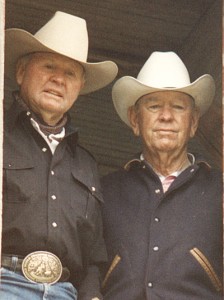 I recently came across an interview I conducted some years ago with Buster Welch and Bob Byrd. Buster won the first two NCHA Futurities (plus three more) and Bob won the third. The two men, close friends born and raised in West Texas, reminisced about their experiences as hired cowhands in the 1930s and 1940s, on ranches that still operated as they had in the days when beef on the hoof, rather than oil, was their most valuable commodity and their remuda a valued resource.
I recently came across an interview I conducted some years ago with Buster Welch and Bob Byrd. Buster won the first two NCHA Futurities (plus three more) and Bob won the third. The two men, close friends born and raised in West Texas, reminisced about their experiences as hired cowhands in the 1930s and 1940s, on ranches that still operated as they had in the days when beef on the hoof, rather than oil, was their most valuable commodity and their remuda a valued resource.
Here’s an excerpt:
Welch:
The thing about those horses and how they were trained – they just had a lot of cattle to work. You can’t realize how much and how long people worked cattle. It was constant.
One time when the wagon was fixing to pull out, I stayed behind with a fella by the name of Joe Wolfe. He was kind of the segundo on the ranch and would do most of the cutting.
In that country, the cattle would walk maybe two days from grass to water and you couldn’t run them off of water too easy. They didn’t want to leave it.
So we’d go down to a big old flat in the water. He’d lead a horse and I’d lead a horse and ride one of those young ones that was kind of broncy.
He’d drive a cow out of there (away from the water) and hold her a little bit a few times. And he did that for three of four days, getting those horses ready to go to work. He trained a lot of ranch working horses, but that was about as much formal training as I ever saw. He just wanted to have them ready for the drive.
Byrd:
Back then they wouldn’t ride the cutting horses on the drive. They’d have somebody take (lead) those horses to the roundup ground where they were going to throw their cattle together and they’d tie those horses there. When they’d come in from the drive, those horses would be there for whoever was going to work the herd.
Welch:
That (cutting) horse was trained pretty well in ranch work and would come to the fore. They used to talk about Foy Proctor having so many good cutting horses to ride. So I said to him, “You must be the best horseman in the world.” And he said, “No. I have over five hundred horses. I watched them and if one looked like it might work, I’d try it.
“I never did ride a horse a second time, if it wasn’t full of cow. Out of five hundred, I always kept eight or ten good horses.”
Byrd:
Horses were six or eight years old before they amounted to a whole lot back then.
Welch:
Horses didn’t mature like they do now, particularly in dry years. A lot of times they wouldn’t break them until they were four. I broke a lot of horses at the X’s that were eight.
Byrd:
They just ran on the grass, no feed.
Welch:
There wasn’t anybody then that trained horses for other people. You trained that horse working cattle (for the ranch) and if it was a good horse, you’d done your job.
We’d ride horses that had a little cow and we’d call them our herd horses. And if they got to watching a cow kind of outstanding, the boss might take them and try and make a cutting horse out of them.
